Resident Crews of the International Space Station (ISS)
![]()
ISS: Expedition 42 |
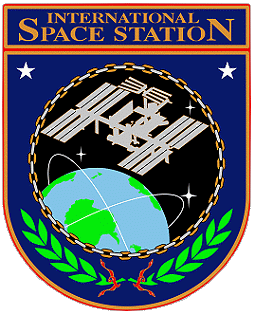 |
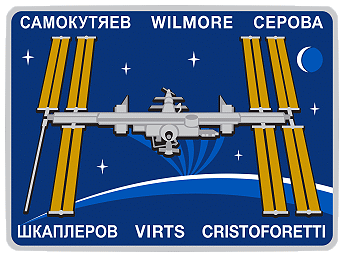 |
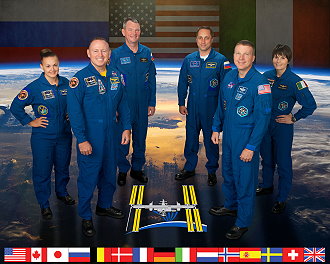 |
alternative crew photo |
|
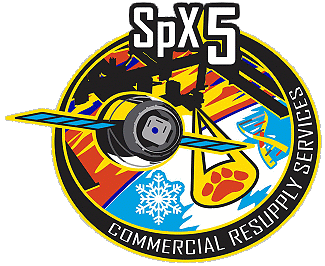 |
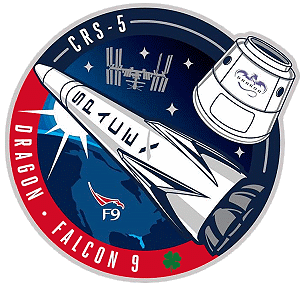 |
![]()
Crew, launch- and landing data
| No. | Nation | Surname | Given names | Position | Spacecraft (launch) |
Launch date |
Launch time |
Spacecraft (landing) |
Landing date |
Landing time |
Mission duration |
Orbits |
| 1 | Wilmore | Barry Eugene "Butch" | ISS-CDR | Soyuz TMA-14M | 25.09.2014 | 20:24:59.939 UTC | Soyuz TMA-14M | 12.03.2015 | 02:07:40.1 UTC | 167d 05h 42m 40s | 2599 | |
| 2 | Samokutyayev | Aleksandr Mikhailovich | Flight Engineer-1 | Soyuz TMA-14M | 25.09.2014 | 20:24:59.939 UTC | Soyuz TMA-14M | 12.03.2015 | 02:07:40.1 UTC | 167d 05h 42m 40s | 2599 | |
| 3 | Serova | Yelena Olegovna | Flight Engineer-2 | Soyuz TMA-14M | 25.09.2014 | 20:24:59.939 UTC | Soyuz TMA-14M | 12.03.2015 | 02:07:40.1 UTC | 167d 05h 42m 40s | 2599 | |
| 4 | Shkaplerov | Anton Nikolayevich | Flight Engineer-4 | Soyuz TMA-15M | 23.11.2014 | 21:01:13.881 UTC | Soyuz TMA-15M | 11.06.2015 | 13:43:56.7 UTC | 199d 16h 42m 43s | 3107 | |
| 5 | Cristoforetti | Samantha | Flight Engineer-5 | Soyuz TMA-15M | 23.11.2014 | 21:01:13.881 UTC | Soyuz TMA-15M | 11.06.2015 | 13:43:56.7 UTC | 199d 16h 42m 43s | 3107 | |
| 6 | Virts | Terry Wayne, Jr. | Flight Engineer-6 | Soyuz TMA-15M | 23.11.2014 | 21:01:13.881 UTC | Soyuz TMA-15M | 11.06.2015 | 13:43:56.7 UTC | 199d 16h 42m 43s | 3107 |
unofficial Backup Crew
| No. | Nation | Surname | Given names | Position |
| 1 | Kelly | Scott Joseph | ISS-CDR | |
| 2 | Padalka | Gennadi Ivanovich | Flight Engineer | |
| 3 | Korniyenko | Mikhail Borisovich | Flight Engineer | |
| 4 | Kononenko | Oleg Dmitriyevich | Flight Engineer | |
| 5 | Yui | Kimiya | Flight Engineer | |
| 6 | Lindgren | Kjell Norwood | Flight Engineer |
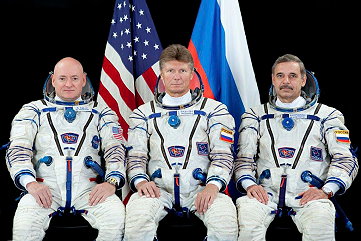 |
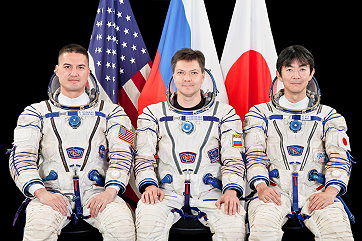 |
 |
Expedition Report
|
Launch from the Baikonur Cosmodrome (Anton
Shkaplerov, Samantha
Cristoforetti and Terry
Virts
with Soyuz
TMA-15M). Aleksandr
Samokutyayev, Yelena
Serova and Barry
Wilmore were onboard since September 26, 2014 (arrival with
Soyuz
TMA-14M). ISS Expedition 42 began with the undocking of spacecraft Soyuz TMA-13M on November 10, 2014 at 00:31:29 UTC. The former Expedition 41 (Maksim Surayev, Reid Wiseman and Alexander Gerst) returned safely to Earth. With the arrival of Soyuz TMA-15M on November 24, 2014 the Expedition 42 became a six-person-crew. Soyuz TMA-15M carried Anton Shkaplerov, Samantha Cristoforetti and Terry Virts to the space station. Observation of the genetic makeup of roundworms, aerosols in the atmosphere, levitating cooling liquid metals and immune cell repair in organisms are some of the highlights of the research to be conducted during Expedition 42. Organisms like roundworms, blue mussels and rodents will be used to examine the impacts of the space environment on their development, growth, and physiological and aging processes. This can lead to understanding better certain diseases and issues associated with human health. In mid-November 2014 Barry Wilmore performed steps to set up the 3D Printer hardware in the Micro-gravity Science glovebox (MSG) Work Volume in preparation for printing. In addition, the crew exchanged filters and then activated the MSG Facility to support MSG payload operations. After setting up the 3D Printer hardware in the MSG, the crew monitored the printing of a coupon (sample) to calibrate the 3D printer. Late in the printing process, the coupon separated from the print tray and the Payload Developer (PD) issued a stop command. The team is standing down for the day and will assess forward steps. The 3-D Printing In Zero-G technology demonstration experiment will show that a 3-D printer can work normally in space. A 3-D printer extrudes streams of heated plastic, metal or other material, building layer on top of layer to create three-dimensional objects. Testing a 3-D printer on the International Space Station is the first step towards establishing a working machine shop in space, a critical component for astronaut missions and in-space manufacturing. On November 25, 2014 Samantha Cristoforetti configured and positioned a video camera in preparation to support the MagVector activation and science run. MagVector qualitatively investigates the interaction between a moving magnetic field (of Earth origin) and a very good electrical conductor. The proposed set up will provide initial insights regarding the principal feasibility on board the ISS, future improvements and phenomenological trends and dependencies. The expected changes in the magnetic field structure on the Ram and Wake side of the electrical conductor are of interest for technical applications as well as for astrophysical research. In the latter case, the ISS / MagVector combination may open a way for experimental astrophysics, e.g. with regard to the interaction between the interplanetary magnetic field and Venus. Astrophysics would thus no longer be based solely on passive observation. Barry Wilmore and ground operations teams deployed the SpinSat on November 28, 2014. The Japanese Experiment Module Airlock (JEMAL) was depressed, the outer hatch opened and the slide table extended. The JEM Remote Manipulator System (JEM RMS) small fine Arm (SFA) guided to grapple the Cyclops launch platform and maneuvered into position for the SpinSat jettison. Once the SpinSat was deployed, the slide table was retracted and the outer hatch closed. The objective of SpinSat experiment is to fly a 22-inch (55,9 Centimeters) diameter spherical satellite equipped with an array of electrically-controlled solid propellant thrusters. It is intended to be a tumbling satellite having a mass of approximately 50 kg with a single axis momentum wheel and multiple micro-thrusters on the sphere's surface. For its initial space flight demonstration, SpinSat aims to test movement and positioning of small satellite in space using new technology micro-thrusters. On December 17, 2014 Terry Virts reviewed a Robonaut video in preparation for upcoming operations. This was the first time motor power was applied to Robonaut following the addition of the legs and upgraded processors. The crew unstowed and set up Robonaut in the US Lab, installing cables for power, motion stop, and Ethernet communications. The ground teams deployed software and received telemetry from Robonaut. However, were unable to obtain the commanded leg movement that was planned for the day. Ground teams are assessing a forward plan. Robonaut is a dexterous humanoid robot designed with the versatility and dexterity to manipulate hardware, exhibit greater endurance than humans and react safely when bumped or interacted with in a way that was not expected. In a milestone for space robotics, the International Space Station has hosted the first full run of ESA's experiment with a force-reflecting joystick. NASA crewmember Barry Wilmore operated the force-feedback joystick to gather information on physiological factors such as sensitivity of feeling and perception limits. He finished a first run on New Year's Eve. The deceptively simple-looking lever is connected to a servomotor that can withstand any force an astronaut operator might unleash on it, while generating forces that the astronaut will feel in turn - just like a standard video gaming joystick as a player encounters an in-game obstacle. The joystick measures such forces at a very high resolution. On January 02, 2015 the crew removed pressure regulator, serial number (SN) 6 from the WHC to try to address black flakes that had been found in the WHC water. The black flakes were identified shortly after SN6 was originally installed. The issue is believed to be related to a new lot of regulators so the crew installed a previously used regulator, SN4. There were no issues with the replacement. In about 2 weeks, when the next flush tank fill is performed, a new EDV will be installed in the "burp bag" location and will be monitored to see whether or not the black flakes persist. Since such a small amount of water is burped during each fill, it may take some time to gain confidence that flakes are no longer present. On January 04, 2015 the WHC faulted with a "Check Dose Pump" indication. Ground teams reviewed available data and determined there had been a failure of the dose pump. There are no US spares on orbit but the pump is identical to one used on the Russian ACY. On January 05, 2015 the crew replaced the dose pump with the Russian spare. A US spare is being flown on SpaceX-5. There was an issue with cap alignment pins while installing the spare pump. This required a cap from the new unit to be swapped with the cap from the old unit. The WHC is now operating nominally. The fifth SpaceX cargo mission (CRS-5 or SpX-5) to the International Space Station (ISS) under NASA's Commercial Resupply Services contract was launched on January 10, 2015 from Space Launch Complex 40 at Cape Canaveral Air Force Station in Florida. The company's Falcon 9 rocket lifted off at 09:47:10 UTC, carrying its Dragon cargo spacecraft. It is loaded with more than 3,700 pounds (1,678 kg) of scientific experiments, technology demonstrations and supplies, including critical materials to support 256 science and research investigations that will take place on the space station during ISS Expeditions 42 and 43. The science research aboard the Dragon includes the Cloud-Aerosol Transport System (CATS), which will characterize and measure the worldwide distribution of clouds and aerosols - the tiny particles that make up haze, dust, air pollutants and smoke; model organism research using fruit flies to study the biological effects of spaceflight; and, a new study using flatworms to better understand wound healing in space. Two days after launching from Cape Canaveral aboard a Falcon 9 rocket, SpaceX's Dragon spacecraft approached the International Space Station with more than 2.5 tons of supplies and experiments on January 12, 2015. Astronaut Barry Wilmore captured the automated spaceship with the station's robot arm at 10:54 UTC and berthed it. Concern about a possible ammonia coolant leak early January 14, 2015 prompted astronauts aboard the International Space Station to evacuate the U.S. segment of the complex, joining three cosmonauts in Russian modules while flight controllers studied telemetry to figure out if alarms were triggered by an actual leak, a computer glitch or some other issue. A few hours later, engineers studying telemetry found no evidence of any leaking ammonia, raising suspicion that a circuit board, or card, in a specific computer known as a multiplexer-demultiplexer, or MDM, might have suffered a failure that took four critical sensors off line. That, in turn, triggered a sequence of events that may have combined to indicate a leak in the station's ammonia coolant system. Joining cosmonauts Aleksandr Samokutyayev, Yelena Serova and Anton Shkaplerov, Barry Wilmore, Samantha Cristoforetti and Terry Virts closed a hatch between NASA's Unity module and the Russian Zarya module, isolating all six crew members in the Russian segment of the lab complex, which uses a different cooling system. Flight controllers then powered down critical systems tied into coolant loop B and shut down an external pump to reduce the pressure in the system. After studying the telemetry, however, engineers saw signs that something in that powerdown process might have triggered the slight change in air pressure that was detected. A real leak was not detected. The engineers think about a possibility of a combination of sensor problems, MDM (computer) partial failures and thermal effects all thrown together in the exact wrong way to make this thing look like it was your classic ammonia leak. Meanwhile the crew returned to the U.S. segment of the complex. On February 03, 2015 the Automated Transfer Vehicle (ATV)-5 experienced a failure with Battery Power Chain #4. ATV ground teams have confirmed the failure is real and not a sensor issue. The ground teams have taken the necessary precautions and are continuing their investigation. The vehicle has a total of four power chains. Should a second power chain failure occur, an expedited undocking would be required within 24 hours per ATV flight rules. SpaceX's Dragon spacecraft departed the space station with 3,700 pounds (1,678 kg) of cargo on February 10, 2015 at 18:15 UTC. SpaceX's Dragon cargo spacecraft splashed down in the Pacific Ocean about 00:44 UTC on February 11, 2015 259 miles southwest of Long Beach, California, with cargo, science and first-of-its-kind technology demonstration samples from the International Space Station. Flight controllers in the Mission Control Center at Johnson Space Center robotically positioned Dragon safely away from its docking port earlier this day, where it was released for its deorbit maneuver, sending it on its way to a parachute-assisted splashdown. Among the returned investigations were printed parts and hardware from the first technology demonstration of 3-D printing in space. The 3-D printer demonstration used relatively low-temperature plastic feedstock on the space station. The test phase ended with a printed ratchet wrench made with a design file transmitted from Earth to the printer. Among the returned investigations were printed parts and hardware from the first technology demonstration of 3-D printing in space. The 3-D printer demonstration used relatively low-temperature plastic feedstock on the space station. The test phase ended with a printed ratchet wrench made with a design file transmitted from Earth to the printer. Dragon also returned samples, hardware and data from several biology and biotechnology studies performed on the station. The Advancing Membrane Protein Crystallization by Using Microgravity investigation explored the production of high-quality crystals of the cystic fibrosis protein and other closely related proteins. Because many medically relevant proteins are difficult to crystalize on Earth, researchers attempt to grow them in space to help determine their shape and structure with the hope of improving drug therapies for cystic fibrosis, a genetic disorder that causes severe damage to the lungs and digestive system. Samples from the Advanced Plant Experiments 03-1 will help scientists better understand the effects of microgravity on the development of roots and cells on plant seedlings. Researchers will conduct a detailed analysis of the returned plant samples to determine the molecular and genetic mechanisms that control plant development in microgravity. With this knowledge, scientists may be able to improve agricultural and bioenergy research on Earth, leading to crops that use resources more efficiently. Onboard was also after an 18-month spaceflight Kirobo, Japan's first robot astronaut. Kirobo is approximately 34 cm (13 in) tall, 18 cm (7.1 in) wide and 15 cm (5.9 in) deep. It weighs about 1 kilogram (2.2 lb) and speaks Japanese. Kirobo is specially designed to navigate zero-gravity environments and assisted Koichi Wakata in various experiments. Its main goal was to see how well robots and humans can interact, hopefully leading the way to robots taking more active roles in assisting astronauts on missions. Dragon is the only space station resupply spacecraft able to return a significant amount of cargo to Earth. The European Space Agency's (ESA) fifth and final Automated Transfer Vehicle (ATV-5) cargo craft departed the station on February 14, 2015. The "George Lemaitre" ATV-5, which arrived at the orbital laboratory August 2014, undocked from the aft port of the Zvezda Service Module at 13:41:57 UTC. After it undocked, the "Georges Lemaitre" moved to a safe distance from the station where it will stay until it was deorbited on February 15, 2015. "Georges Lemaitre" is the fifth and final spacecraft in the series of European supply vehicles that began servicing the station in the spring of 2008. In all, the ATVs delivered approximately 34 tons of supplies to the complex while docked to the station for 776 days. The ship's reentry into the atmosphere over the South Pacific Ocean will be documented by the Expedition 42 crew on board the station as well as NASA, ESA and other agencies around the world to gather detailed information on the mechanics of the breakup of a spacecraft reentering the Earth's atmosphere. A prototype "blackbox for spacecraft" running inside ESA's cargo ferry as it burned up in the atmosphere managed to return data to the ground but, sadly, the images it took were lost in transit. Aboard ATV-5 was the Break-Up Camera, designed to record ATV's death throes in the infrared and transfer the results to the SatCom heatshield-protected sphere. Surviving the break-up, SatCom then should broadcast its stored data to Iridium telecom satellites as it plummets back to Earth. The unmanned Russian freighter Progress M-26M launched on February 17, 2015 at 11:00:17 UTC from the Baikonur Cosmodrome in Kazakhstan with almost three tons of food, fuel and supplies for the station's Expedition 42 crew. Progress M-26M was scheduled to make its four-orbit, six-hour trip to the space station for docking. The freighter docked at 16:57:11 UTC with the Zvezda Service Module. The first spacewalk (EVA) in Expedition 42 was performed by Barry Wilmore and Terry Virts on February 21, 2015 (6h 41m). The astronauts started routing cables for the International Docking Adapter (IDA). In preparation for the arrival of new commercial crew vehicles to the ISS in late 2017 (at this time planned) - which will use a brand new docking system - the existing docking ports on the ISS need to be converted to the new standard, before any commercial crew vehicles can dock to the outpost. The International Docking Adapters are a critical component of the station's reconfiguration to ensure long-term docking ports for future commercial crew and other visiting spacecraft. They will permit the standard station crew size to grow from six to seven, potentially doubling the amount of crew time devoted to research aboard the orbiting laboratory. The two new docking adapters will be launched to the station on a pair of SpaceX Dragon cargo spacecraft in 2015. Astronauts will install the first of two adapters on Pressurized Mating Adapter-2 on the forward end of the station's Harmony module during a future spacewalk. The second adapter will be installed on Pressurized Mating Adapter-3 after it is relocated robotically to the space-facing port of Harmony later in 2015. Barry Wilmore and Terry Virts spent most of their time working at the front of the station at the forward end of the Harmony module where a docking port extension known as Pressurized Mating Adapter No. 2 is attached. PMA-2 is where visiting space shuttles once docked and where one of the new IDAs will be attached later this year. After removing micrometeoroid shields from the forward end cone of Harmony, the spacewalkers unplugged no-longer-needed cables and installed new power and data lines to support IDA-1. All in all, Barry Wilmore and Terry Virts deployed about 340 feet (110 meters) of cable. Barry Wilmore and Terry Virts ventured out the station on February 25, 2015 for a second spacewalk (6h 43m). The astronauts unfurled and hooked up two more long cables and Terry Virts lubricated the grapple fixture on the end of the space station's robot arm (SSRMS). Barry Wilmore and Terry Virts laid out eight bundles of cables near the front of the space station that will supply power and data to new docking port mechanisms that will be launched and installed later in 2015. They first removed a protective cover from a docking port extension on the front end of the space station that was once used by visiting space shuttles. The cover turned out to be fairly stiff, but the astronauts managed to stuff it in a stowage bag as planned. The spacewalkers then stowed no-longer-needed shuttle power cables that were disconnected on February 21, 2015 before installing two final sets of power and data cables needed by the docking mechanisms. Terry Virts spent more than two hours lubricating the intricate capture mechanisms on the end of the station's Canadian-built robot arm. Using a long tool known as a BLT, for ball-screw lubricating tool, Terry Virts applied the grease to internal components in a bid to reduce friction in the mechanism when the capture systems are activated. Barry Wilmore worked on the left side of the station around the Tranquility module, making preparations for upcoming module relocations. He removed a protruding valve and a handrail to improve clearances for one of the modules moves and released launch locks on Tranquility's forward and aft berthing ports. After the spacewalk ended and the two astronauts were safely back inside the airlock, Terry Virts reported detecting dampness in his helmet absorption pad, a precaution added to the suit after a 2013 EVA when ESA astronaut Luca Parmitano's helmet filled with water. Video sent down of Terry Virts still inside his suit showed a "blob" of about 3-inches of water inside his helmet. Despite the water, Terry Virts was never in danger. On March 01, 2015 Barry Wilmore and Terry Virts left the space station for the third EVA (5h 38m). They installed new antennas and cabling needed for communications between the station and commercial crew capsules bound for, or departing from, the new docking adapters. The new communications system is called the Common Communications for Visiting Vehicles (C2V2), and is designed to provide a standardized communications link between the ISS and its growing fleet of Visiting Vehicles (VVs), including uncrewed cargo and future commercial crew vehicles. Epigenetics in Space flown C. elegans (Epigenetics): Epigenetics means "outside the genes", or changes that can be inherited for several generations without affecting an organism's basic DNA. This Japan Aerospace Exploration Agency study may help determine if the effects of microgravity are transmitted from one cell generation to another without changing the basic DNA of an organism. Researchers study millimeter-long roundworms (C. elegans) as models for larger organisms. In this investigation, four generations of the worms are grown aboard the space station, with adults from each generation preserved for later study on Earth. Cloud-Aerosol Transport System (CATS): The CATS study examines the location, composition and distribution of aerosols - the particles that compose haze, dust, smoke and air pollutants - in the atmosphere. Aerosols are the atmospheric constituents that can affect weather, climate, airplane safety and human health. The CATS instrument measures aerosols using a light detection and ranging (LIDAR) system that is externally mounted on the space station. With the data, scientists may gain an improved understanding of the structure and evolution of Earth's atmosphere. This can lead to enhancements to spacecraft launch, landing and communications systems; help guide future atmospheric investigations of Mars, Jupiter or other worlds; and may help researchers model and predict climate changes on Earth. Electromagnetic Levitator (EML): The EML suite of material science investigations examines the effects of microgravity on various material properties. The EML acts as a furnace capable of levitating and heating metals up to 3,632 degrees Fahrenheit. Having such a facility in microgravity will allow scientists to observe the fundamental physical processes that occur as liquid metals cool. A potential outcome from EML research is the development of lighter, higher-performing alloys - mixtures of two or more metals or a metal and another material - for use on Earth and in space travel. Gene, Immune and Cellular Responses to Single and Combined Space Flight Conditions - B (TripleLux-B): Gaining a better understanding of the effects of spaceflight at the cellular level of an organism may help scientists develop countermeasures to combat impairment of immune function in crew members on future long-duration missions. The TripleLux-B investigation compares the immune cells of blue mussels and rodents to determine how those cells fight bacteria and repair themselves after exposure to radiation and microgravity. Finally, the station command changed from US astronaut Barry Wilmore to US astronaut Terry Virts. With undocking of Soyuz TMA-14M, carrying Aleksandr Samokutyayev, Yelena Serova and Barry Wilmore, on March 11, 2015 at 22:44:02 UTC the Expedition 42 concluded and the new ISS Expedition 43 began. During the stay on board of the ISS the crews of Expeditions 41 / 42 carried out the following scientific experiments: 3D Printing In Zero-G (3D Printing In Zero-G Technology Demonstration) 3DA1 Camcorder (Panasonic 3D Camera) ACE-H-1 (Advanced Colloids Experiment-Heated-1) ACE-H-2 (Advanced Colloids Experiment-Heated-2) ACE-M-3 (Advanced Colloids Experiment-Microscopy-3) AES-1 (Antibiotic Effectiveness in Space-1) AIRWAY MONITORING (AIRWAY MONITORING) AMO-TOCA (Autonomous Mission Operations TOCA Autonomous Operations Project) AMS-02 (Alpha Magnetic Spectrometer - 02) APEX-03-1 ( Advanced Plant EXperiments 03-1) APEX-03-2 TAGES-Isa (Transgenic Arabidopsis Gene Expression System - Intracellular Signaling Architecture) Amine Swingbed (Amine Swingbed) Aniso Tubule (Roles of cortical microtubules and microtubule-associated proteins in gravity-induced growth modification of plant stems) Area PADLES (Area Passive Dosimeter for Life-Science Experiments in Space) Astro Palate (Factors Contributing to Food Acceptability and Consumption, Mood and Stress on Long-Term Space Missions) BCAT-C1 (Binary Colloidal Alloy Test - C1) BP Reg (A Simple In-flight Method to Test the Risk of Fainting on Return to Earth After Long-Duration Space Flights) BRIC-19 (Biological Research in Canisters-19 ) Biochem Profile (Biochemical Profile) Bioculture System Validation (Bioculture System) Biological Rhythms 48hrs (The effect of long-term microgravity exposure on cardiac autonomic function by analyzing 48-hours electrocardiogram) Bisphosphonates (Bisphosphonates as a Countermeasure to Space Flight Induced Bone Loss) Blind and Imagined (SLINK: move Short bLind plus shrink - Moving blind and throwing an imagery ball) Body Measures (Quantification of In-Flight Physical Changes - Anthropometry and Neutral Body Posture) CALET (CALorimetric Electron Telescope) CARTILAGE (CARTILAGE) CATS (Cloud-Aerosol Transport System) CEO (Crew Earth Observations) CFE-2 (Capillary Flow Experiment - 2) CREAM (Cosmic Ray Energetics and Mass) Cardio Ox (Defining the Relation Between Biomarkers of Oxidative and Inflammatory Stress and Atherosclerosis Risk in Astronauts During and After Long-duration Spaceflight) Cell Mechanosensing-2 (Cell Mechanosensing-2) Check-Saliva (Salivary Markers of Metabolic Changes during Space Missions) Circadian Rhythms (Circadian Rhythms) Cognition (Individualized Real-Time Neurocognitive Assessment Toolkit for Space Flight Fatigue) Comm Delay Assessment (Assessing the Impact of Communication Delay on Behavioral Health and Performance: An Examination of Autonomous Operations Utilizing the International Space Station) Cyclops Demo (Cyclops Hardware Validation Demonstration) DECLIC DSI-R (DEvice for the study of Critical LIquids and Crystallization - Directional Solidification Insert-Reflight) DECLIC HTI-R (DEvice for the study of Critical LIquids and Crystallization - High Temperature Insert-Reflight) DOSIS-3D (Dose Distribution Inside the International Space Station - 3D) DTN (Disruption Tolerant Networking for Space Operations) Drain Brain (Strain-gauge Plethysmographic Analysis of the CErebral DRainage Experimented and Assessed in the Micro-gravitational Setting) Drug Metabolism (Repurposing Metformin as an anti-cancer agent: microgravity studies in Saccharomyces cerevisiae) Dynamic Surf (Experimental Assessment of Dynamic Surface Deformation Effects in Transition to Oscillatory Thermo capillary Flow in Liquid Bridge of High Prandtl Number Fluid) EPO-Demos (Education Payload Operation-Demonstrations) ESA-EPO-GERST (European Space Agency - Education Payload Operations GERST) EXHAM-CFRP Mirror (Space Environmental Testing of Lightweight and High-Precision Carbon Composite Mirrors) EXHAM-Solar Sail (Space Environment Exposure Tests of Functional Thin-Film Devices for Solar Sail) Embryo Rad (Lifetime Heritable Effect of Space Radiation on Mouse embryos Preserved for a long-term in ISS) Energy (Astronaut's Energy Requirements for Long-Term Space Flight) Exerc-Orthostatic Tolerance (Structured Exercise Training as Countermeasure to Space Flight-Induced Orthostatic Intolerance) FLEX-2 (Flame Extinguishment Experiment - 2) Fluids Education (Fluids Education) Force Shoes (In-flight Demonstration of Portable Load Monitoring Devices-Phase I: XSENS ForceShoe™) Functional Task Test (Physiological Factors Contributing to Postflight Changes in Functional Performance) HDEV (High Definition Earth Viewing) HREP-HICO (HICO and RAIDS Experiment Payload - Hyperspectral Imager for the Coastal Ocean) HREP-RAIDS (HICO and RAIDS Experiment Payload - Remote Atmospheric and Ionospheric Detection System (RAIDS)) HiMassSEE (Spacecraft Single Event Environments at High Shielding Mass) IMAX (IMAX Documentary film: A PERFECT PLANET) ISERV (ISS SERVIR Environmental Research and Visualization System) ISS Ham Radio (International Space Station Ham Radio) ISS-RapidScat (ISS-RapidScat) IVA Clothing Study (Intravehicular Activity Clothing Study) Intervertebral Disc Damage (Risk of Intervertebral Disc Damage after Prolonged Space Flight) JAXA PCG (Japan Aerospace Exploration Agency Protein Crystal Growth) JAXA-Commercial (Japan Aerospace Exploration Agency - Commercial Payload Program) Journals (Behavioral Issues Associated with isolation and Confinement: Review and Analysis of Astronaut Journals) Kikuchi-Kossel (Structure analyses and particle interaction studies of Colloid by laser diffractometry in microgravity) LONESTAR (Low Earth Orbiting Navigation Experiment for Spacecraft Testing Autonomous Rendezvous and Docking) MAXI (Monitor of All-sky X-ray Image) MCE (Multi-mission Consolidated Equipment) METERON (METERON Quick Start a / DTN) MICAST-2 (The Microstructure Formation in Casting of Technical Alloys under Diffusive and Magnetically Controlled Convective Conditions-2) MISSE-8 FSE (MISSE-8 FSE) MVIS Controller-1 (MVIS Controller 1) Manual Control (Assessment of Operator Proficiency Following Long-Duration Space Flight) Marangoni-UVP (Spatio-temporal Flow Structure in Marangoni Convection) Meteor (Meteor Composition Determination) Microbe-IV (Microbiological monitoring in the International Space Station-KIBO) Microbiome (Study of the Impact of Long-Term Space Travel on the Astronauts' Microbiome) Multi-Gas Monitor (Multi-Gas Monitor) NIH-Osteo (Gravitational Regulation of Osteoblast Genomics and Metabolism) NanoRacks-COBRA PUMA GOLF-Electroplating (NanoRacks-COBRA PUMA GOLF-Electroplating) NanoRacks-Duchesne Light Wavelengths on Algae Production (NanoRacks-Duchesne-Algae Production in Microgravity with Variable Wavelengths of Light) NanoRacks-Food Growth Chamber (NanoRacks-Plant Viability for Food Growth Chamber) NanoRacks-Lipid Mimic Self-Assembly (NanoRacks-Self-Assembly of Mesoscopic Lipid Mimics) NanoRacks-Micro-gRx (NanoRacks-Fluorescent Polarization in Microgravity) NanoRacks-NanoRocks (NanoRacks-NanoRocks: Collisional Evolution of Particles and Aggregates in Microgravity) NanoRacks-PCG Therapeutic Discovery (NanoRacks-Protein crystal growth in microgravity to enable therapeutic discovery) NanoRacks-Planet Labs-Dove (NanoRacks-Planet Labs-Dove) NanoRacks-Slime Mold (NanoRacks-Slime Mold Organization) Nematode Muscles (Alterations of C. elegans muscle fibers by microgravity) NeuroMapping (Spaceflight Effects on Neurocognitive Performance: Extent, Longevity, and Neural Bases) OPALS (Optical PAyload for Lasercomm Science) Ocular Health (Prospective Observational Study of Ocular Health in ISS Crews) Osteo-4 (Osteocytes and mechano-transduction) PK-4 (Plasma Krystall-4) PS-TEPC (Establishment of dosimetric technique in the International Space Station (ISS) with Position Sensitive Tissue Equivalent Proportional Chamber) Plant Gravity Sensing 1 (Utilization of the micro gravity condition to examine the cellular process of formation of the gravity sensor and the molecular mechanism of gravity sensing) Plant Gravity Sensing-2 (Utilization of the micro gravity condition to examine the cellular process of formation of the gravity sensor and the molecular mechanism of gravity sensing) Plant Rotation (Plant circumnutation and its dependence on the gravity response) Pro K (Dietary Intake Can Predict and Protect Against Changes in Bone Metabolism during Spaceflight and Recovery) RRM-Phase 2 (Robotic Refueling Mission Phase 2) Radi-N2 (Radi-N2 Neutron Field Study) Radiation Environment Monitor (Radiation Environment Monitor) Repository (National Aeronautics and Space Administration Biological Specimen Repository) Robonaut (Robonaut) Rodent Research-1 (Rodent Research Hardware and Operations Validation) Rodent Research-1 (CASIS) (Muscle Atrophy of Muscle Sparing in Transgenic Mice) Rodent Research-2 (NASA #1) ( Rodent Research-2 (NASA #1) Impact of Spaceflight on Primary and Secondary Antibody Responses) Rodent Research-2 (NASA #2) ( Rodent Research-2 (NASA #2) Implications for Elevated Intracranial Pressure) SCAN Testbed (Space Communications and Navigation Testbed) SEDA-AP (Space Environment Data Acquisition Equipment - Attached Payload) SNFM (Serial Network Flow Monitor) SPHERES-Slosh (SPHERES-Slosh) SPHERES-Zero-Robotics (Synchronized Position Hold, Engage, Reorient, Experimental Satellites-Zero-Robotics) STP-H4-ATT (Space Test Program-Houston 4-Active Thermal Tile) STP-H4-FireStation (Space Test Program-Houston 4-FireStation) STP-H4-GLADIS (Space Test Program - Houston 4 - Global Awareness Data-Exfiltration International Satellite) STP-H4-ISE 2.0 (Space Test Program-Houston 4-ISS SpaceCube Experiment 2.0) STP-H4-MARS (Space Test Program-H4-Miniature Array of Radiation Sensors) STP-H4-SWATS (Space Test Program-Houston 4- Small Wind and Temperature Spectrometer) Salivary Markers (The Effects of Long-Term Exposure to Microgravity on Salivary Markers of Innate Immunity) Sally Ride EarthKAM (Sally Ride Earth Knowledge Acquired by Middle School Students) Seedling Growth-2 (Seedling Growth-2) Skin-B (Skin-B) Solar-SOLACES (Sun Monitoring on the External Payload Facility of Columbus - SOLar Auto-Calibrating EUV/UV Spectrophotometers) Solar-SOLSPEC (Sun Monitoring on the External Payload Facility of Columbus -Sun Monitoring on the External Payload Facility of Columbus -SOLar SPECtral Irradiance Measurements) Space Aging (Study of the effects of space flight on the aging of C. elegans) Space Headaches (Space Headaches) Space Pup (Effect of space environment on mammalian reproduction) SpinSat (SpinSat) Sprint (Integrated Resistance and Aerobic Training Study) Stem Cells (Study on the Effect of Space Environment to Embryonic Stem Cells to Their Development) Story Time From Space (Story Time From Space) Synergy (The elucidation of the re-adaptation on the attitude control after return from long term space flight) T-Cell Act in Aging (T-Cell Activation in Aging) TripleLux-B (Gene, Immune and Cellular Responses to Single and Combined Space Flight Conditions - B) UBNT (Ultrasonic Background Noise Test) V-C REFLEX (Plastic alteration of vestibulo-cardiovascular reflex and its countermeasure) VIABLE ISS (eValuatIon And monitoring of microBiofiLms insidE International Space Station) Vessel ID System (Vessel ID System) Wearable Monitoring (Wearable System for Sleep Monitoring in Microgravity) Windows on Earth (Windows on Earth) Zebrafish Muscle (Effects of the gravity on maintenance of muscle mass in zebrafish). |
EVA data
| Name | Start | End | Duration | Mission | Airlock | Suit | |
| EVA | Wilmore, Barry | 21.02.2015, 12:45 UTC | 21.02.2015, 19:26 UTC | 6h 41m | ISS-42 | ISS - Quest | EMU No. 3003 |
| EVA | Virts, Terry | 21.02.2015, 12:45 UTC | 21.02.2015, 19:26 UTC | 6h 41m | ISS-42 | ISS - Quest | EMU No. 3005 |
| EVA | Wilmore, Barry | 25.02.2015, 11:51 UTC | 25.02.2015, 18:34 UTC | 6h 43m | ISS-42 | ISS - Quest | EMU No. 3003 |
| EVA | Virts, Terry | 25.02.2015, 11:51 UTC | 25.02.2015, 18:34 UTC | 6h 43m | ISS-42 | ISS - Quest | EMU No. 3005 |
| EVA | Virts, Terry | 01.03.2015, 11:52 UTC | 01.03.2015, 17:30 UTC | 5h 38m | ISS-42 | ISS - Quest | EMU No. 3005 |
| EVA | Wilmore, Barry | 01.03.2015, 11:52 UTC | 01.03.2015, 17:30 UTC | 5h 38m | ISS-42 | ISS - Quest | EMU No. 3003 |
Photos
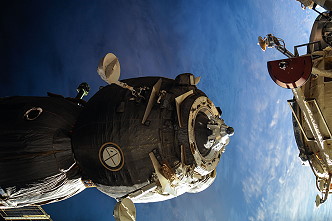 |
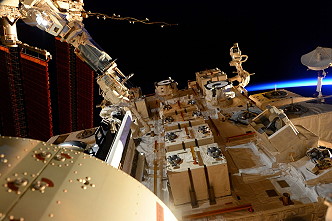 |
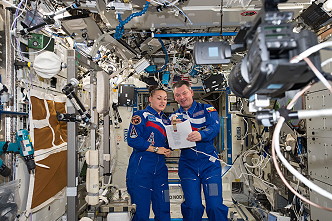 |
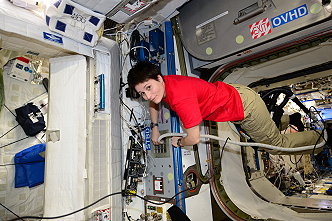 |
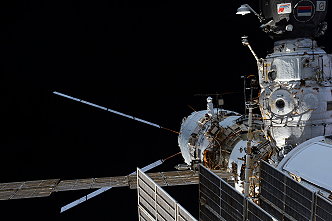 |
 |
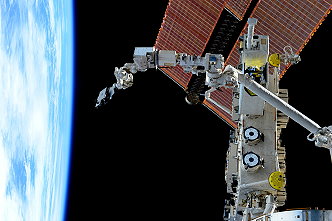 |
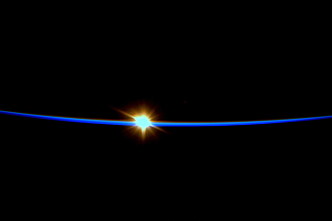 |
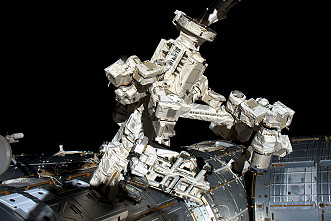 |
 |
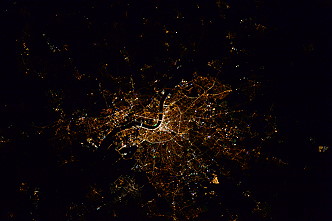 |
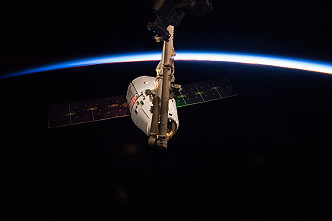 |
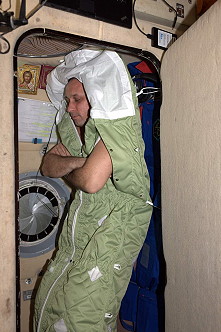 |
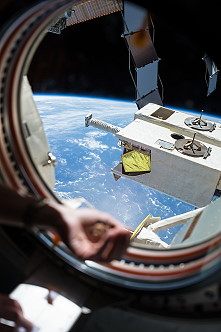 |
 |
 |
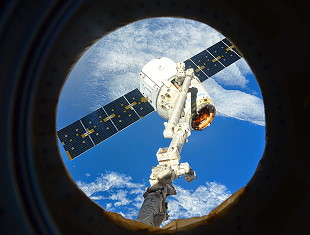 |
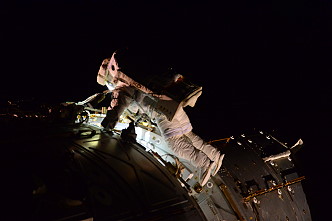 |
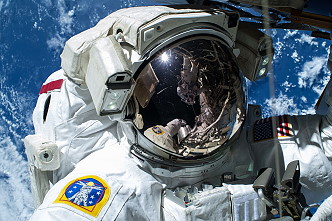 |
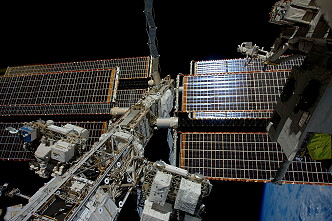 |
 |
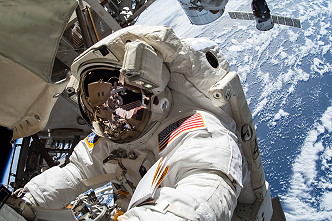 |
 |
 |
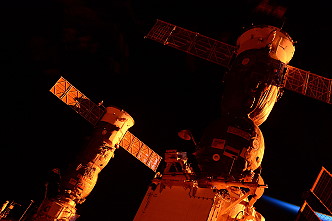 |
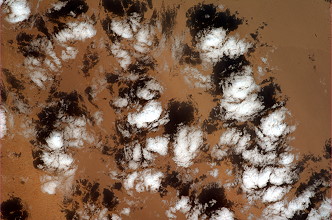 |
more Earth observation photos |
|
more EVA photos |
|
more onboard photos |
|
| © |  |
Last update on December 15, 2020.  |
 |